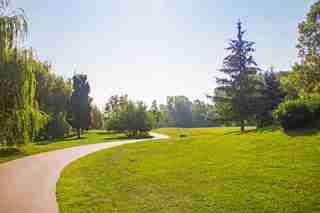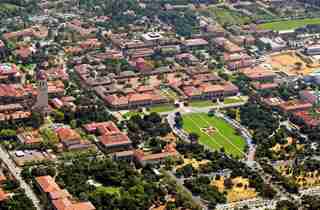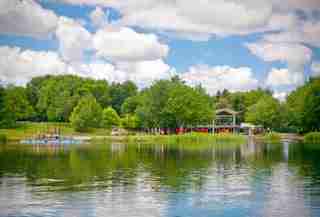Often called the father of modern landscape architecture, Frederick Law Olmsted is nothing short of a demigod in the field. Best known for his masterful creation of Central Park, the Connecticut-born Olmsted, along with his partner, British architect Calvert Vaux, developed a distinctly American style that would come to characterize some of the nation’s most cherished public spaces. Olmsted worked for years as a journalist before developing his craft with Vaux, and the duo gained quick fame after winning New York City’s Central Park commission in 1857. What followed was an influx of projects quite literally spanning from coast to coast, from North Carolina’s Biltmore Estate to the master scheme for Stanford University. Long story short: If you look hard enough, you can certainly find some Olmsted in your backyard. Here, AD spotlights beautiful Olmsted works that are hidden in plain sight.

City park system, Buffalo, New York, 1868
After visiting Buffalo in 1868, Olmsted managed to convince city officials that one park would not be enough to properly serve its residents. As a result, the first public park system in the U.S. was born, comprising what are known today as the Delaware (shown), Front, Martin Luther King Jr., South, Cazenovia, and Riverside parks.

Master campus plan for Stanford University, Palo Alto, California, 1886
Commissioned by the Stanfords themselves, Olmsted transformed a plot of Palo Alto farmland into an organized campus featuring dramatic sightlines and supporting quadrangles with Palm Drive at its center. Vestiges of the original plan are still visible today.

Parc du Mont-Royal, Montreal, 1876
Perched high above the Montreal skyline, the 500-acre Parc du Mont-Royal is one of the city’s largest green spaces. After the prime site lost many of its trees to firewood gathering and cold weather, Olmsted was brought in to develop the space, though not all of his final designs were executed.
The Lawrenceville School, Lawrenceville, New Jersey, 1883
Olmsted designed a park-style campus for the elite private preparatory school in northern New Jersey. Much of Olmsted’s original design, including the planting of 371 trees, can still be seen today.
Elm Park, Worcester, Massachusetts, 1866
Recently benefiting from a renovation, Worcester’s Elm Park was designed on land specifically purchased with the intent of creating park space, a first in the U.S. at the time.
Belle Isle Park, Detroit, 1880s
Michigan’s Belle Isle Park clocks in at just under 1,000 acres and is situated between the U.S. and Canada in the Detroit River. Though only a portion of Olmsted’s designs were brought to life in the park, the space is notable for changing environmental discourse around Detroit in the late 19th century.
Groton School, Groton, Massachusetts, 1884
Circles take thematic dominance in Olmsted’s plan for northwestern Massachusetts’s Groton School. The main campus green is encircled with buildings by the landscape designer’s contemporaries at architectural firm Peabody & Stearns.
The Biltmore Estate, Asheville, North Carolina, 1895
One of his final projects, the Biltmore was different for Olmsted in that it was backed by the prosperous Vanderbilts, leaving the designer with a budget far exceeding that of his usual public works. Olmstead directed the layout of the estate and persuaded the family to include a 250-acre commercial timber forest.
Prospect Park, Brooklyn, 1867
Many New Yorkers do not know that, in addition to Central Park, Olmsted and Vaux also designed Brooklyn’s Prospect Park, a 585-acre green space sandwiched at the nexus of the borough’s Park Slope, Prospect Heights, Windsor Terrace, Ditmas Park, and Lefferts Gardens neighborhoods. The space, which was inspired by England’s Birkenhead park, features a 60-acre lake, an impressive watercourse, and meandering trails aplenty.

Leave a Reply